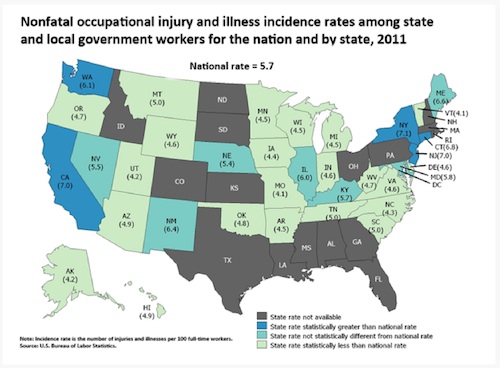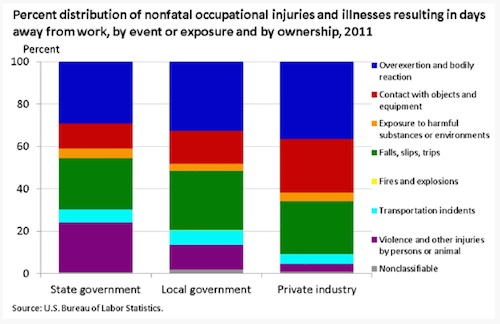BLS Issues Report on Worker Injuries
Report covers injuries to government and private industry workers by sector and occupation.
A new BLS (Bureau of Labor Statistics) Spotlight on Statistics reports focuses on injuries to workers. The scope of the Survey of Occupational Injuries and Illnesses was expanded with the 2008 survey to cover a more complete section of the U.S. economy: state and local government workers.
Prior to the publication of the 2008 survey results, data users commonly requested information about industries in the public sector. Estimates covering nearly 18.5 million state and local government workers show that these public sector employees experienced a higher incidence rate of work-related injuries and illnesses than their private industry counterparts.
This Spotlight on Statistics compares characteristics of injury and illness cases in state and local government with those in private industry, highlighting incidence rate trends in selected state and local government industries and examining injury and illness rates and cases that occurred in state and local government workplaces in 2011.

Nonfatal injury and illness rate greater than national average in five states
Among the 34 states for which data are available, the total recordable case injury and illness rates for state and local government were higher in 5 states than the national rate of 5.7 cases per 100 full-time workers. The rates were lower than the national rate in 22 states and not statistically different from the national rate in 7 states.
State-level public sector estimates were unavailable for 16 states and the District of Columbia for various reasons, such as lack of state funding or failure to meet BLS reliability criteria.
Among the states for which 2011 estimates are available, New York recorded an injury and illness incidence rate among state and local government workers of 7.1 cases per 100 full-time employees, which is statistically higher than the national rate.
By contrast, Missouri and Vermont each registered a rate of 4.1 cases, which was statistically lower than the national rate.
Some of these differences in incidence rates across states can be attributed to different industry composition among state and local government workers within each of the states.
State and local government workers accounted for about 22 percent of nonfatal injuries and illnesses

















